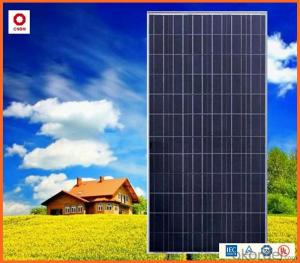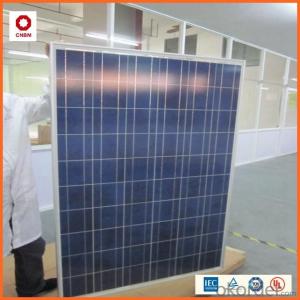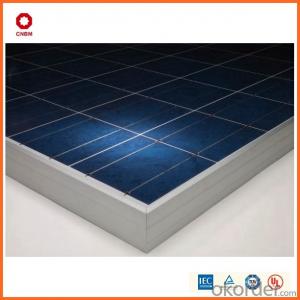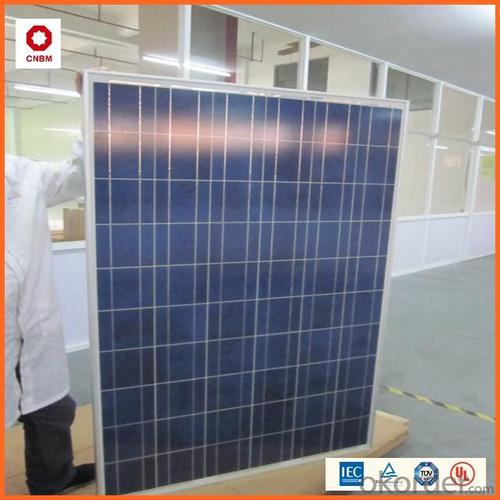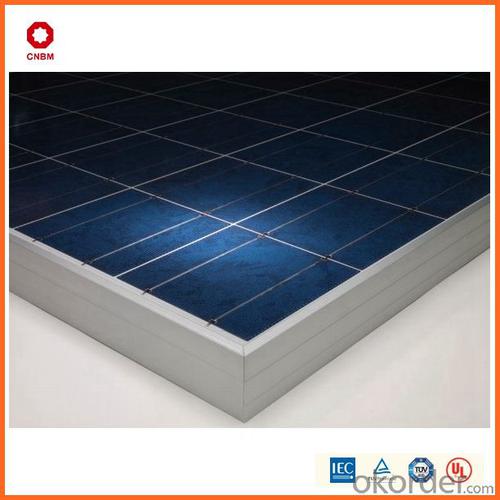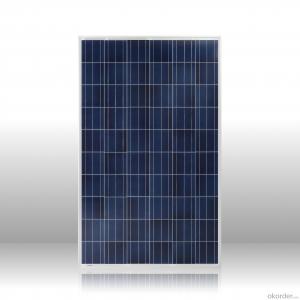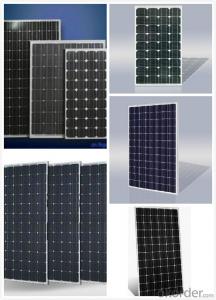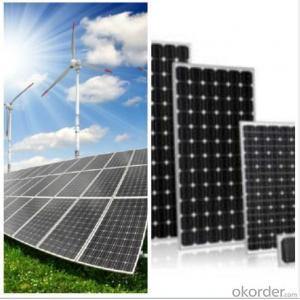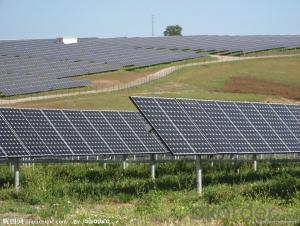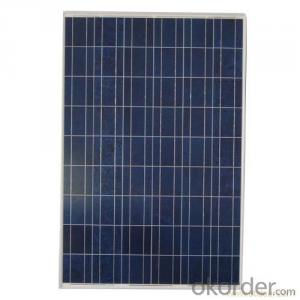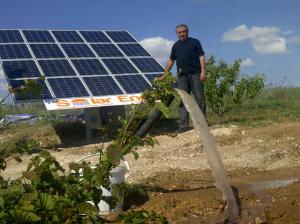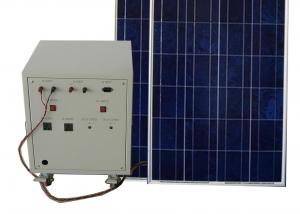Various Solar Energy Systems - 250W Poly Solar Panel 0.45/W A Grade Good Quality
- Loading Port:
- China main port
- Payment Terms:
- TT OR LC
- Min Order Qty:
- 1 watt
- Supply Capability:
- 10000000 watt/month
OKorder Service Pledge
OKorder Financial Service
You Might Also Like
Product Description:
Hot Sale !!! Quality and Safety of 245w-320w Poly Solar Panel
1. Rigorous quality control meets the highest international standards.
2. High-transmissivity low-iron tempered glass, strong aluminium frame.
3. Using UV-resistant silicon.
4. IS09001/14001/CE/TUV/UL
Warranties of 245w-320w Poly Solar Panel
1. 10 years limited product warranty
2. 15 years at 90% of the minimal rated power output
3. 25 years at 80% of the minimal rated power output
Technical date of 245w-320w Poly Solar Panel
ITEM NO.: | Mono 125*125 cell ,36pcs . Power range from 80Wp-100Wp | ||||||||
Maximum Power(W) | 80 | 85 | 90 | 95 | 100 | ||||
Optimum Power Voltage(Vmp) | 17.81 | 17.89 | 17.94 | 17.99 | 18.06 | ||||
Optimum Operatige Current(Imp) | 4.78 | 4.91 | 5.12 | 5.35 | 5.59 | ||||
Open Circuit Voltage(Voc) | 21.98 | 22.05 | 22.14 | 22.28 | 22.45 | ||||
Short Circuit Current(Isc) | 4.95 | 5.15 | 5.36 | 5.65 | 5.84 | ||||
Solar Cell: | 125*125 Mono | ||||||||
Number of Cell(pcs) | 4*9 | ||||||||
Brand Name of Solar Cells | JA Cell, Bluesun Cell | ||||||||
Size of Module(mm) | 1580*808*35 | ||||||||
Caple & Connector Type | Pass the TUV Certificate | ||||||||
Frame(Material Corners,etc.) | Aluminium-alloy | ||||||||
Backing (Brand Type) | TPT | ||||||||
Cell Efficiency for 100W(%) | 15.8% | ||||||||
Weight Per Piece(KG) | 12.0KG | ||||||||
FF (%) | 70-76% | ||||||||
Junction Box Type | Pass the TUV Certificate | ||||||||
Tolerance Wattage(e.g.+/-5%) | ±3%, or 0-3% | ||||||||
Front Glass Thikness(mm) | 3.2 | ||||||||
Temperature Coefficients of Isc(%) | +0.04 | ||||||||
Temperature Coefficients of Voc(%) | -0.38 | ||||||||
Temperature Coefficients of Pm(%) | -0.47 | ||||||||
Temperature Coefficients of Im(%) | +0.04 | ||||||||
Temperature Coefficients of Vm(%) | -0.38 | ||||||||
Temperature Range | -40°C to +85°C | ||||||||
Surface Maximum Load Capacity | 2400Pa | ||||||||
Allowable Hail Load | 23m/s ,7.53g | ||||||||
Bypass Diode Rating(A) | 12 | ||||||||
Warranty | 90% of 10 years,80% of 25 years. | ||||||||
Standard Test Conditions | AM1.5 1000W/ 25 +/-2°C | ||||||||
Packing | carton or pallet | ||||||||
1*20' | 25 Pallets / 450pcs | ||||||||
1*40'STD | 25 Pallets / 100pcs | ||||||||
Features of our products:
• High conversion efficiency mono/poly-crystalline amorphous silicon solar cells
• Modules incorporate high performance bypass diodes to minimize the power drop caused by shading
• High transmittance, low-iron tempered glass
• High performance EVA encapsulant to prevent destroying and water.
• AI frame: without screw, corner connection. 8 holes on the frame can be installed easily
• Good performance of preventing from atrocious weather such as wind and hails
• Certifications: CE IEC TUV VDE UL, Class I
• 10 years 90% power output warranty
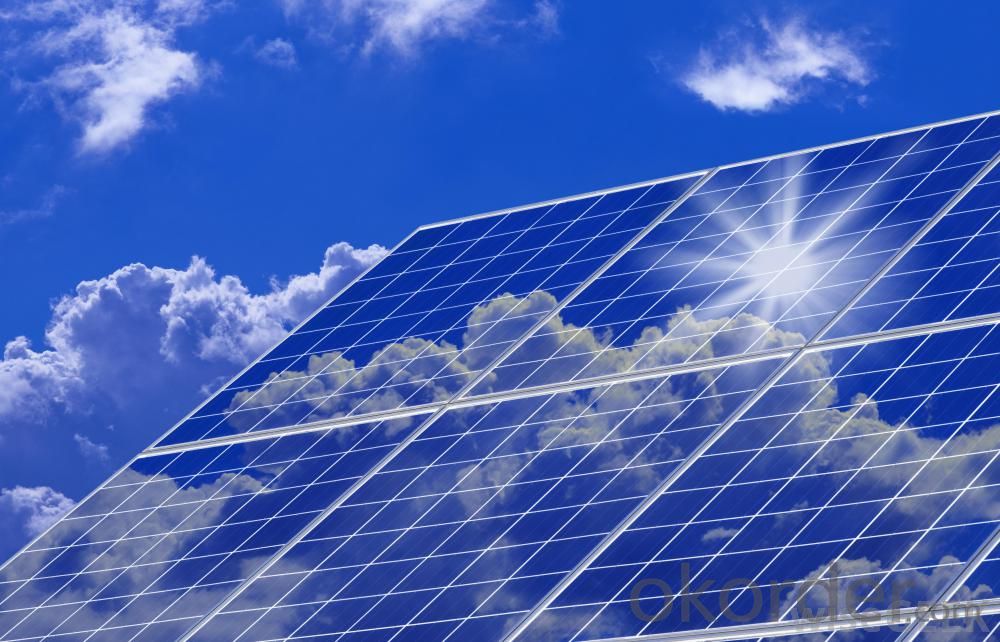
Shipping of 245w-320w Poly Solar Panel
By Sea | Delivery from Shanghai or Ningbo seaport |
By Air | Departure from Shanghai Pudong Airport |
By Express | Post by DHL, EMS, UPS, TNT. |
- Q: Can solar energy systems be installed on historic buildings?
- Yes, solar energy systems can be installed on historic buildings. However, it is important to consider the sensitivity of the building's preservation and design. Careful planning and collaboration with historic preservation experts are required to ensure that the installation does not compromise the architectural integrity of the historic structure.
- Q: Can solar energy systems be used for powering electric plane systems?
- Yes, solar energy systems can be used to power electric plane systems. In fact, the idea of using solar power for aviation has gained significant traction in recent years. Solar panels can be installed on the wings and fuselage of an aircraft to capture sunlight and convert it into electricity. This electricity can then be used to power the plane's systems, such as navigation, communication, lighting, and auxiliary power units. While it is currently not feasible to solely rely on solar power for the main propulsion of a commercial plane due to the limited energy density of solar panels, solar energy can still play a valuable role in reducing the overall energy consumption of an aircraft. By utilizing solar power for auxiliary systems, electric planes can significantly reduce their reliance on traditional fossil fuel-based power sources. Solar-powered electric planes have already shown promising results in various experimental and small-scale projects. For instance, Solar Impulse 2, a solar-powered aircraft, completed a round-the-world journey in 2016, demonstrating the potential of solar energy in aviation. Additionally, NASA has been actively exploring the application of solar energy in their electric aircraft research. However, there are still challenges to overcome in order to fully integrate solar energy systems into commercial aviation. The efficiency and weight of solar panels need to be improved to generate sufficient power for larger aircraft. Additionally, advanced energy storage technologies must be developed to store excess solar energy for use during low-sunlight conditions or nighttime flights. Despite these challenges, the potential benefits of using solar energy in aviation are significant. Solar-powered electric planes have the potential to reduce carbon emissions and dependence on fossil fuels, leading to a more sustainable and eco-friendly aviation industry. As technology continues to advance, the integration of solar energy systems into electric plane systems will likely become more feasible and widespread.
- Q: Can solar energy systems be used in areas with limited access to solar panel manufacturers?
- Yes, solar energy systems can still be used in areas with limited access to solar panel manufacturers. In such cases, the focus would be on importing solar panels from manufacturers in other regions or countries. Additionally, efforts can be made to promote local manufacturing or assembly of solar panels to overcome the limitations and ensure the availability of solar energy systems in those areas.
- Q: What is the maintenance schedule for a solar energy system?
- The maintenance schedule for a solar energy system typically involves regular inspections and cleanings to ensure optimal performance and efficiency. Additionally, it is recommended to check the connections, wiring, and inverter functionality periodically. Most manufacturers provide guidelines on maintenance tasks, and it is advisable to follow their recommendations to ensure the longevity and reliability of the system.
- Q: Can solar energy systems be used in powering theme parks or water parks?
- Certainly, theme parks and water parks can indeed utilize solar energy systems to meet their power requirements. Solar energy is a renewable and clean power source that offers a sustainable and cost-effective solution for fulfilling the energy needs of these establishments. The operation of attractions, lighting, water pumps, and other facilities in theme parks and water parks demands a significant amount of electricity. By installing solar panels, these establishments can decrease their dependence on traditional energy sources and minimize their carbon footprint. The vast open spaces available in theme parks and water parks provide excellent opportunities for installing solar panels, which can be mounted on rooftops, carports, or ground-mounted arrays. Solar energy systems generate electricity by converting sunlight into usable energy through photovoltaic (PV) panels. These panels can be discretely and efficiently integrated into the park's infrastructure. The energy produced during the day can be instantly utilized to power rides, lighting, and other equipment, while any surplus energy can be stored in batteries for use during periods of low sunlight or at night. Moreover, solar energy systems offer a reliable power source, reducing the vulnerability of theme parks and water parks to power outages or disruptions in the grid. This is especially crucial in areas prone to extreme weather events. By incorporating backup battery storage systems, solar energy can provide a continuous and uninterrupted power supply even during emergencies. Apart from the environmental and reliability advantages, solar energy systems also present long-term cost savings for theme parks and water parks. Although the initial installation cost may be higher, operational expenses are significantly lowered as the sun provides free and abundant energy. Over time, the savings on electricity bills can compensate for the initial investment, resulting in substantial cost savings for the park's proprietors. In summary, solar energy systems have the potential to revolutionize the power supply of theme parks and water parks. By harnessing the energy of the sun, these establishments can not only reduce their environmental impact but also achieve long-term cost savings and enhanced energy reliability.
- Q: What is the role of solar batteries in storing excess solar energy?
- The role of solar batteries in storing excess solar energy is to capture and store the energy produced by solar panels during times of peak sunlight, allowing it to be utilized later when sunlight is not available, such as during the night or on cloudy days. This enables a more reliable and consistent supply of renewable energy, reducing dependence on the grid and increasing self-sufficiency.
- Q: What is the difference between solar energy systems and solar panels?
- Solar energy systems refer to the complete setup that harnesses and utilizes solar energy, including solar panels, inverters, batteries, and other components necessary to convert sunlight into usable electricity. On the other hand, solar panels are the main component of a solar energy system, responsible for capturing sunlight and converting it into direct current (DC) electricity. In summary, solar panels are just one part of a larger solar energy system.
- Q: Can a solar energy system be installed on a commercial building?
- Yes, a solar energy system can be installed on a commercial building. In fact, many businesses have embraced solar power as a sustainable and cost-effective solution for their energy needs. Installing a solar energy system on a commercial building offers multiple benefits, including reduced electricity bills, potential tax incentives and rebates, increased property value, and a positive brand image associated with environmental responsibility. Commercial buildings typically have ample rooftop space, making them ideal for solar panel installation. Additionally, advancements in solar technology have made it easier and more efficient to integrate solar systems into commercial buildings. With proper planning and professional installation, a solar energy system can provide clean and renewable energy to power various operations within a commercial building, contributing to a greener and more sustainable future.
- Q: How does a solar thermal system use sunlight to heat water or air?
- A solar thermal system uses sunlight to heat water or air by capturing the solar energy through solar panels or collectors. These panels contain tubes or pipes filled with a heat transfer fluid, such as water or antifreeze. When sunlight hits the panels, the fluid inside absorbs the heat and becomes hot. This hot fluid is then circulated through a heat exchanger, where it transfers its heat to the water or air that needs to be heated. In this way, solar thermal systems harness the energy from sunlight to provide a sustainable and efficient method of heating water or air.
- Q: Can solar energy systems be installed in areas with extreme weather conditions?
- Yes, solar energy systems can be installed in areas with extreme weather conditions. However, the performance and durability of the system may vary depending on the specific weather conditions. Proper design, installation, and maintenance can help ensure that solar systems can withstand extreme weather events such as hurricanes, snowstorms, or high winds. Additionally, advancements in solar technology have made it possible to adapt systems to various weather conditions, making solar energy a viable option in areas with extreme weather.
Send your message to us
Various Solar Energy Systems - 250W Poly Solar Panel 0.45/W A Grade Good Quality
- Loading Port:
- China main port
- Payment Terms:
- TT OR LC
- Min Order Qty:
- 1 watt
- Supply Capability:
- 10000000 watt/month
OKorder Service Pledge
OKorder Financial Service
Similar products
Hot products
Hot Searches
Related keywords

